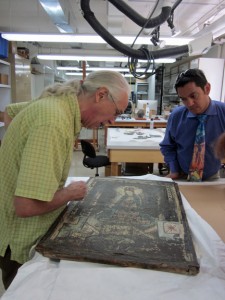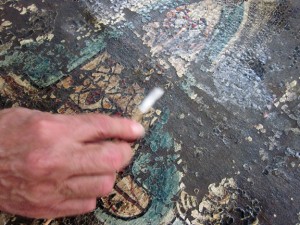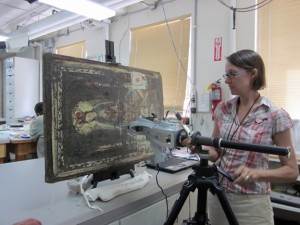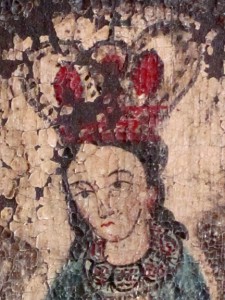We told you recently about the Conservation Lab’s investigation into the probable painting-behind-a-painting of Nuestra Señora de San Juan de los Lagos (Our Lady of Saint John of the Lakes). Today, the painting took a trip to Albuquerque, where a friendly radiologist and his staff put her under their high-tech equipment for a look more intense than Museums of New Mexico equipment allows.
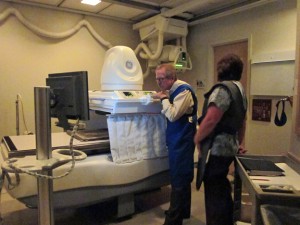 Dr. Jim Lowry (at left, with radiographer Cassie Barth) at El Camino Imaging Center invited Museum Resoures Division Conservator Mina Thompson and History Museum curator Josef Diaz to bring the painting in after another physician relayed our suspicions and limitations to him. He volunteered the use of his center’s equipment and staff, intrigued as we were at this unusual juncture of art, history and science.
Dr. Jim Lowry (at left, with radiographer Cassie Barth) at El Camino Imaging Center invited Museum Resoures Division Conservator Mina Thompson and History Museum curator Josef Diaz to bring the painting in after another physician relayed our suspicions and limitations to him. He volunteered the use of his center’s equipment and staff, intrigued as we were at this unusual juncture of art, history and science.
Here’s the painting’s story, in a nutshell: Contract conservator Steven Prins had uncovered some evidence of an earlier painting beneath the ca. 1820 image painted by José Aragón while cleaning the waxy, sooty, flaked and cracked canvas. Thompson, the lead conservator in the investigation, aimed the Conservation Lab’s best equipment at it and found some evidence that indicated there were indeed two layers of paint containing different minerals — one sign that the paintings were done in different eras.
The painting comes from the New Mexico History Museum’s Larry Frank Collection, which includes numerous examples of Aragón’s bultos and retablos. Paintings on canvas were rare in his 1820-1850 creative arc, because the medium was difficult to obtain in northern New Mexico’s frontier conditions.
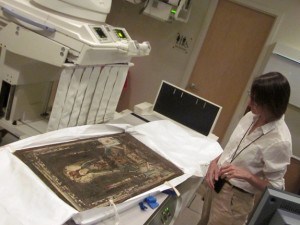 One theory holds that the initial painting came up El Camino Real and hung in a church or home where it suffered some kind of damage. At that point, Aragón may have been hired to re-create the image or develop a new one — an option he likely would have jumped at just for the chance to try something new.
One theory holds that the initial painting came up El Camino Real and hung in a church or home where it suffered some kind of damage. At that point, Aragón may have been hired to re-create the image or develop a new one — an option he likely would have jumped at just for the chance to try something new.
At the imaging center, Lowry, Barth and lab manager Beth Rocco put the painting through a series of X-ray workouts of various intensities, each time crowding around computer screens to see what might be revealed. Early on, a ghostly image raised a flutter of intrigue: What appeared to be three lines of a signature or inscription glowed on the screen, tantalizingly. A different intensity of image, though, showed the lines to be part of the crown that Our Lady wears in the visible part of the painting, with the X-ray machine picking up on the lead or mercury contained in the red paint.
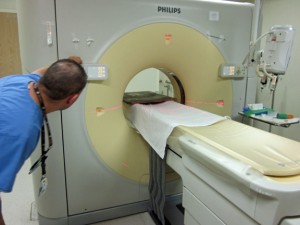 As further images failed to produce anything more conclusive than some curious dots, the technician who runs the center’s CT scan offered to put the painting into its tube during a rare 10-minute break in his patient schedule. With that test, we could photograph thin-as-skin layers of the painting, which we hoped would give us a better idea of what lies beneath.
As further images failed to produce anything more conclusive than some curious dots, the technician who runs the center’s CT scan offered to put the painting into its tube during a rare 10-minute break in his patient schedule. With that test, we could photograph thin-as-skin layers of the painting, which we hoped would give us a better idea of what lies beneath.
Alas, there was no clear-cut answer, at least immediately. Thompson is taking a series of images back to the Conservation Lab, where she’ll piece them together and see whether she can make some better conclusions about the hands that have worked this canvas. “It’s going to take some interpreting,” she said. (Just so you know, and we’re not kidding here: Should any scientists at the Los Alamos or Sandia labs be willing to offer up even more high-tech equipment, we’ll be there.)
The effort became something of a group exercise at El Camino Imaging, with various physicians and technicians weighing in with their suggestions. Lowry admitted that he had spent some time on Google looking for other examples of X-ray paintings.
“This is fun,” Rocco said. “We had a little bit of experience a few years back when we did a CT on a mummy for a museum. Radiology gets to do some interesting things–not that our patients aren’t interesting, but this is out of the usual realm. We don’t have to ask this `patient’ to hold their breath.”
We extend our deepest gratitude to Dr. Jim Lowry, Cassie Barth, Beth Rocco, and all the other staff members who helped make today possible. In addition, we’d like to thank Dr. Margaret Chaffey and Dr. Malcolm Purdy. She doesn’t speak very often, so we can’t ssay for certain, but we’re pretty sure Our Lady had a good time, too.

